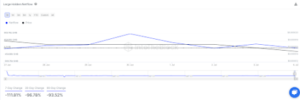
The zeitgeist in technology today is all about artificial intelligence, so in an effort to drive more users and usage, LinkedIn is catering to the buzz. On Thursday, it took the wraps off a raft of new services powered by AI.
The company is betting big on AI and people’s appetite to see it threaded through experiences on the platform, and is bringing out yet more tools using AI, specifically generative AI, to get things done on the site. New features include using more natural prompts to look for jobs or suitable candidates, and then providing generative AI tools to help people with their job applications (yes, there’s a tool to write the whole application and cover letter for you); AI to surface relevant learning material (to learn more about AI, naturally); and generative AI to search all of LinkedIn to find what you need more quickly.
There are a few significant things to note about LinkedIn’s current focus on AI.
First, as we have pointed out before, this is not LinkedIn’s first AI rodeo. The company has been threading the tech into its products from its earliest days, and you could argue that there is very little that AI is not touching at the company.
“We’ve been building with AI since 2007,” its head of product, Tomer Cohen, said in an interview with TechCrunch this week. Indeed, the company’s connection suggestions, which have often felt very uncanny in what they surface, is one example of where that has played out. “We use it heavily for connecting people… for defense [security] and how we keep trust in the ecosystem. It’s one of our most powerful tools.”
The big change that LinkedIn does not want to miss is the one that has swept the rest of the tech world: The wave of AI-powered tools aimed at helping ordinary people do human-centric tasks.
LinkedIn has already been active in that area. It launched a suite of OpenAI-powered tools in October 2023, adding reading and writing tools one month later, as well as tools to help with writing profiles, recruitment ads and company pages.
Second, LinkedIn has different expectations to meet than some of its peers when it comes to the current wave of AI tools. Big social players like Meta or X have found themselves facing different degrees of existential crises over the explosion of interest in generative AI. How will they respond to it? How will they lead it? Should they? Perhaps more directly, how do they make sure that the new-new-thing doesn’t cut their businesses out of the next stage of growth?

LinkedIn is a part of Microsoft, which has a 49% stake in OpenAI and a substantial raft of its own AI efforts. Effectively, this takes the pressure off LinkedIn itself of innovating or investing in innovators, leaving it to concentrate on how it can build or integrate tools for its own purposes.
That’s not to say that LinkedIn doesn’t have its own metrics to hit, and that it won’t be looking at tapping AI to stay current in the market. And it will still leave a lot of question marks around what LinkedIn chooses to explore to that end. The company is most certainly under the eye of regulators: just last week, it was dinged by regulators in Europe over how it targeted ads based on data from those users’ participation in different LinkedIn groups.
Third, there is something a little ironic about LinkedIn adding in so many more AI features in areas where it’s being used help users take their hands off the wheel when it comes to creating content on the site.
After many years of people joking about how LinkedIn feels somewhere between creepy and cheesy — people get stalked on there for dealmaking, or jobs; people shamelessly self-promote and schmooze — it’s suddenly found itself as an island of calm for working people from the algorithmic acrobatics of Facebook and Instagram spam and the Elonification of what was once Twitter.
LinkedIn touts the idea of presenting your “authentic” self on the platform: not only by boosting its new verified profile feature (40 million users have been verified now, just a small fraction, so there’s some way to go); but through the many, many pieces of “thought leadership” you get on the site itself about the merits of being authentic.
Yet by introducing more ways to use AI to write resumes, update your profile, write letters and other posts, you have to ask just what authentic really means, or how much it’s really valued.
Below is a run-down of some of the new features:
Job searches and job applications. We’re getting a new way to search for jobs using conversational prompts. It still relies on the data and the job actually existing, of course. For example, finding jobs in journalism in London that pay a salary of at least £100,000 may not turn up much, no matter how many ways you phrase it.
Once you have found jobs and want to apply, you can now generate a cover letter or a letter of introduction, and the AI will also give you a further review of your résumé and other work you’re doing.
Learning personalisation. LinkedIn continues to be bullish on its video-based learning platform, and it appears to have found a strong current among users who need to skill up in AI. Cohen said that traffic for AI-related courses — which include modules on technical skills as well as non-technical ones such as basic introductions to generative AI — has increased by 160% over last year.
You can be sure that LinkedIn is pushing its search algorithms to tap into the interest, but it’s also boosting its content with AI in another way.
For Premium subscribers, it is piloting what it describes as “expert advice, powered by AI.” Tapping into expertise from well-known instructors such as Alicia Reece, Anil Gupta, Dr. Gemma Leigh Roberts and Lisa Gates, LinkedIn says its AI-powered coaches will deliver responses personalized to users, as a “starting point.”
These will, in turn, also appear as personalized coaches that a user can tap while watching a LinkedIn Learning course.
The third big area LinkedIn is leaning heavily on AI is search. If you already use LinkedIn in any way, you’ll know that this is very long overdue, as search has been one of the most neglected parts of the experience on the platform, especially as the platform has grown.
LinkedIn says it will provide more detail on the new search experience in the coming weeks, but expect to see a lot more conversational search as a simpler alternative or replacement for its current search experience, which uses keywords, network distance, geography and other parameters but never feels like it’s giving you the complete answer.
Alongside all this, LinkedIn is expanding availability of Recruiter 2024, adding more tools for marketers, and introducing enhanced, premium company pages for small businesses.





